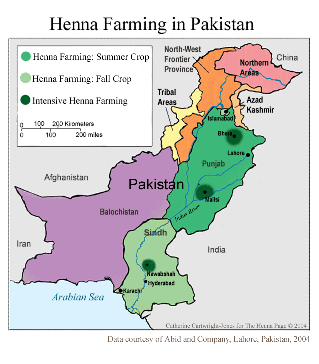|
Henna Farming
in Pakistan
Resource material and photographs supplied by Abid & Company ( Pvt) Ltd. Catherine Cartwright-Jones © 2004 Pakistan’s henna producing provinces are Punjab and Sindh. In Punjab, the intensive henna farming districts are Bhera and Mailsi. In Sindh, the intensive henna-farming district is Nawabshah. Farmers in other areas of Punjab and Sindh also grow henna, but to a lesser extent. Punjab is a productive agricultural area, producing two crops a year, both summer and winter. The Punjabi henna-growing region receives on average 170mm (7”), falling during two seasons. The summer monsoons bring rain from June to September, and winter rains fall between December and March. There is no rain between these seasons. The heat is most intense in May, before the monsoon, often 105 to115 F, and may reach 120F or more (40 to 50C). The henna crops are harvested at the end of the dry seasons, just as the two rainy seasons begin. The crop following a hot, dry season has a higher Lawsone content than that following a cool season. A henna crop harvested after a rainy season has lower Lawsone content than that following a dry season. During the summer season, Kharif season, farmers also raise rice, cotton, sugarcane, and maize. During the winter season, Rabi season, farmers also raise wheat and vegetable crops. 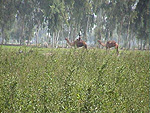 Click HERE for a larger picture, and more pictures! Farmers in Sindh raise henna, particularly in Nawabshah, the main henna-growing region of Sindh. In this region, winter minimums average 62F, (17C), and summer highs average 104 - 113 F (40 - 45C). Most years have less than 170 mm (7”) rainfall annually, and in many drought years there is less than 75 mm (3”) precipitation, again falling between June and September, December and March. Farmers in Sindh grow bananas, dates, and mangos as well as the winter and summer crops raised in Punjab. Hotter, drier climate produces higher dye content in henna. Punjab has hotter summers than Sindh, so the summer crop of Punjabi henna is superior to the Sindhi summer crop, and the Punjabi summer crop has the highest Lawsone content of the year. Both regions also harvest a second fall crop of henna, two or three months after the monsoons. Because Sindh has warmer autumns than Punjab, the Sindhi winter henna crop has higher dye content than the Punjabi winter crop. Henna survives with very little water, and farmers can harvest a crop with only one or two rains. Some farmers harvest a third crop in September after the monsoon rains, but the Lawsone content in that crop is lower, due to the higher precipitation through the growing period. 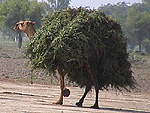 Click HERE for a larger picture, and more pictures! There is no henna farming in Balochistan, Kashmir, and the northwestern provinces. Henna will not survive a hard freeze, and thrives only in areas where the winter minimum is over 11 C or 50F. Balochistan has occasional frosts that would kill henna. Kashmir and the northern provinces have colder wonders, with heavy snows. The northernmost area has permanent glaciers, and very severe winter temperatures. Since henna is a small tree, and must remain in the ground for many years, it only thrives in climates that are frost-free for decades at a time. Planting and Growing Henna Pakistani farmers plough henna seeds into moist, fertile beds to germinate and grow. When the small plants are established, they are transplanted into larger fields where they can stay for many years. They are set into rows where they will grow with enough room between the plants for easy weeding and harvesting. The farmer may fertilize the henna with organic fertilizer if the soil is very poor, or irrigate the field if there is no rain. There are raised borders around the henna fields to catch all the rain possible. If there is no rain, the farmer may open a channel from the irrigation canal to bring in water. Men take care of the fields, with their wives and adult children helping them. Occasionally, the family cow will get into the henna field and nibble the henna. This leaves red stains on the cow’s mouth, like lipstick!  Click HERE for a larger picture, and more pictures! When henna grows in the wild, antelopes and other browsing animals nibble henna branches during drought, leaving droppings nearby. When rains come, henna quickly puts out new growth, fed by water and fertilizing dung. The plant protects this new growth from hungry animals with a high level of bitter tannin, Lawsone, in the leaves. The henna farmer takes advantage of henna's natural growth habits by pruning the new shoots full of Lawsone-rich leaves as soon after the first seasonal rain. Any time henna is pruned, and given water and nutrients, it rapidly regrows new leafy branches. A farmer can harvest two crops in each year’s growth cycle, harvesting from the same plant season after season. Henna trees on commercial plantations do not grow larger than bushes because of this constant pruning. 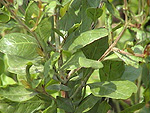 Click HERE for a larger picture, and more pictures! Henna must be harvested within the month of new growth or the leaves begin to turn yellow, and the dye degrades. Two months after new growth, the leaves may fall off the plant, and be useless commercial harvesting. Therefore, if you know exactly when to expect the first rains and the first harvests, you know when the finest henna will be available! If you watch the weather in various henna growing regions, observing heat and precipitation, you may be able to predict where the finest crops will be harvested, take advantage of the finest crops and avoid the poor crops! 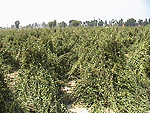 Click HERE for a larger picture, and more pictures! Pakistani farmers harvest henna twice a year. The summer crop is harvested is at the end of May or the beginning of June, depending on the onset of the monsoon rains. The fall crop is harvested in November or December. These crops have the highest dye content because of the heat and drought preceding these harvests. Some farmers also harvest an intermediate crop in August or September after the monsoon season. This crop usually has 60 - 70% of the dye content of the summer crop, and is sold locally, or exported to countries that do not buy the more expensive henna. When the farmer decides his henna crop is ready, he harvests by pruning off the new growth. His family helps in the harvesting operation. The farmer clips the shoots, and stacks them to dry. The farmer hopes the heavy monsoon rains will not come too quickly and spoil the crop as it dries. They move the dried shoots near the road so a they can be picked up for cleaning. The leaves are separated from the straws, cleaned, and then moved to depots for sale. The straws are used as fuel for cooking fires and winter heating. A small family farm harvests around 100 maunds (one maund is 40kg or 88 pounds) in every crop, for two crops a year. A farmer can harvest 20 to 35 maunds of henna leaves from an acre of land, depending on the soil and care, so each family has 3 to 5 acres planted in henna. 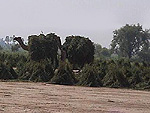 Click HERE fora larger picture, and more pictures! Abid & Company ( Pvt) Ltd., Purchasing and Processing Jamila Henna The Abid and Co. team of experts purchase a farmer’s henna crop two to four weeks prior to harvesting, and also purchase leaves of selected henna fields directly from the farmers. 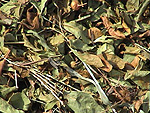 Click HERE for a larger picture, and more pictures! Abid & Co monitors the henna as it is harvested and sun-dried, to be certain the leaves crisp for grinding and cleaning. Workers remove dust and straw from the leaves. 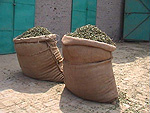 Click HERE for a larger picture, and more pictures! The clean leaves are bagged and taken to the grinding machines. These are kept in a temperature-controlled environment to obtain the best results. High temperatures could degrade quality. The veins of the leaves are removed by sifting machines sifting machines, and the henna powder is cleaned from its impurities. This process is repeated until a silk smooth powder is obtained which is hygienic and safe to be used on human hair and skin. The powder quality is re-checked and finally approved for Jamila Henna, then it is packaged and shifted to the warehouse. Osman Ali
Abid & Company (Pvt) Ltd 8-B, Darbar Market, Ganj Bukhsh Road, Lahore- Pakistan. E-mail: osmanali@jamila.com.pk abidco@jamila.com.pk Tel: 92-42-7243663, 92-42-7115733 Fax: 92-42-7249956 URL: www.jamila.com.pk Web resources for
Pakistan:
http://www.multimap.com/index/PK.htmhttp://countrystudies.us/pakistan/ http://www.settlement.org/cp/english/pakistan/landclim.html http://www.pakistaneconomist.com/database1/cover/c2003-28.asp http://www.mapzones.com/world/asia/pakistan/mapindex.php Web resources for Punjab http://www.cet.edu/earthinfo/sasia/punjab/PJtopic4.html http://www.punjabilok.com/pakistan/pak_punjab.htm http://www.fao.org/WAICENT/FAOINFO/ http://www.comsats.org.pk/latest/munir_sheikh.pdf Additional maps of Pakistan: http://www.cet.edu/earthinfo/sasia/SAmain.html Can't find what you're looking for? Try: The Henna Page Main Index http://www.hennapage.com/henna/mainindex.html *"Henna,
the
Joyous Body Art"
the Encyclopedia of Henna Catherine Cartwright-Jones c 2000 registered with the US Library of Congress TXu 952-968 |
